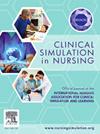Development and usability of the mixed reality–based intubation nursing simulation: A mixed methods study
IF 2.5
3区 医学
Q1 NURSING
引用次数: 0
Abstract
Background
Integrating mixed reality (MR) into nursing simulation education, particularly for procedural training such as endotracheal intubation, offers a promising avenue to the repetitive training of practical execution and collaboration. This study aimed to develop an MR-based intubation nursing (MRIN) simulation tailored for nursing professionals and focused on usability.
Methods
This study used a mixed methods design. The MRIN scenario with eight steps was developed using HoloLens 2 and evaluated by 12 nursing master’s students experienced in intubation. After two simulation sessions, quantitative data for the simulation task load index (SIM-TLX) and task completion time were evaluated, while qualitative data were gathered through think aloud (TA) interviews.
Results
The subtotal task load of the SIM-TLX decreased from 4.25/10 ± 2.21 in the first simulation to 3.08/10 ± 1.37 in the second simulation, with reduced task completion time. TA interviews highlighted the need for modifications to enhance realism, procedural accuracy, and the program’s strengths.
Conclusion
The MRIN simulation represents an advancement in MR technology for nursing education, offering an immersive and effective platform for procedural training.
基于混合现实的插管护理模拟的开发和可用性:一项混合方法研究
将混合现实(MR)融入护理模拟教育,特别是气管插管等程序性培训,为实践执行和协作的重复性培训提供了一条有前途的途径。本研究旨在为护理专业人员开发一种基于核磁共振的插管护理(MRIN)模拟,并关注其可用性。方法采用混合方法设计。采用HoloLens 2开发了8个步骤的磁共振成像场景,并由12名有插管经验的护理硕士学生进行评估。在两次模拟后,评估模拟任务负荷指数(SIM-TLX)和任务完成时间的定量数据,并通过出声思考(TA)访谈收集定性数据。结果SIM-TLX的小计任务负荷由第一次模拟时的4.25/10±2.21降至第二次模拟时的3.08/10±1.37,任务完成时间缩短。助教访谈强调了修改的必要性,以增强真实性、程序准确性和项目的优势。结论磁共振成像模拟是磁共振技术在护理教育中的一个进步,为程序性培训提供了一个身临其境的有效平台。
本文章由计算机程序翻译,如有差异,请以英文原文为准。
求助全文
约1分钟内获得全文
求助全文
来源期刊

Clinical Simulation in Nursing
NURSING-
CiteScore
5.50
自引率
15.40%
发文量
107
期刊介绍:
Clinical Simulation in Nursing is an international, peer reviewed journal published online monthly. Clinical Simulation in Nursing is the official journal of the International Nursing Association for Clinical Simulation & Learning (INACSL) and reflects its mission to advance the science of healthcare simulation.
We will review and accept articles from other health provider disciplines, if they are determined to be of interest to our readership. The journal accepts manuscripts meeting one or more of the following criteria:
Research articles and literature reviews (e.g. systematic, scoping, umbrella, integrative, etc.) about simulation
Innovative teaching/learning strategies using simulation
Articles updating guidelines, regulations, and legislative policies that impact simulation
Leadership for simulation
Simulation operations
Clinical and academic uses of simulation.
 求助内容:
求助内容: 应助结果提醒方式:
应助结果提醒方式:


